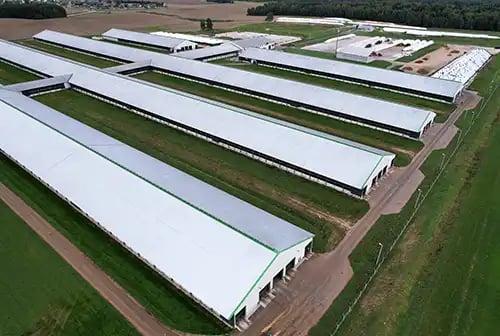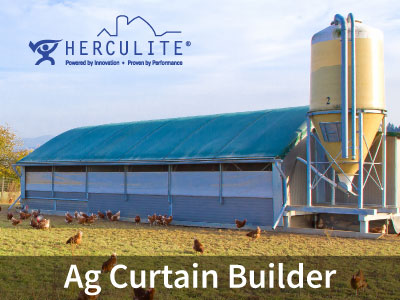Herculite® Agriculture Fabrics
Herculite’s long-life curtains are the industry standard for the poultry, hog, and dairy markets. Herculite Ag Curtains regulate ventilation quickly, conveniently and efficiently. These curtains are available using clear, translucent white, blackout fabrics, and specialty constructions are manufactured to order.

The Key Benefits of Herculite Curtain Fabrics
Proudly made in America at our facility in Emigsville, located in the heartland of Pennsylvania's agricultural region, Herculite Ag Curtains have been the industry standard for many years. The high-quality product is engineered to protect livestock from the elements while being durable enough to withstand everyday use.
Poultry - 9.5 Ounce
Lightweight, flexible, and easy to install and handle. Great for poultry applications, this 9.5-ounce textile is available in black, white, or translucent.
Lightweight Crystal Clear - 11 Ounce
Extreme clarity in an exceptionally lightweight 11-ounce textile.
Standard Duty - 13 Ounce
Heavy Duty - 16 Ounce
R²X Protection
Herculite Ag curtain with R²X is designed to be resistant to environmental damage. When a Herculite Ag Curtain with R²X is combined with good curtain care and maintenance, it will increase the life and performance of your curtain.
Sonic Stitch Hem
Sonic Stitch is a propriety weld offered on Herculite Agriculture Curtains that combines a heated weld with double stitching to give our customers the best possible protection from failing hems. These welds become the strongest part of the curtain.
Need more information?
How do I maintain my Herculite Agricultural Curtains?
Herculite personnel have talked with hundreds of producers over the past 30 years and visited dozens of sites. Over the years, we have learned some simple practices to help extend your curtain's life. This article highlights some basic and simple “best practices” that can be used to extend your curtain's life, saving you money and increasing profit.
Installation Tips
Install curtain when the temperature is above 40 degrees Fahrenheit
While Herculite Curtain is rated to withstand cold temperatures over -30 degrees Fahrenheit, it may be good to fold, roll, crumple, or aggressively handle the material at those cold temperatures. As a best practice, install curtains above 40 degrees Fahrenheit to prevent premature damage to the material during installation.
During the installation of the curtain, avoid nailing through the stitch of the hem.
We have observed over the years that on a gravity drop curtain, it is sometimes the practice to nail the curtain in the up position while either the pipe is being put into the hem and the roping system is installed to raise or lower the curtain. On a rare occasion, a hem has failed because while nailing the material up, a nail pierced the thread used to sew the stitch, causing the hem to unravel. Simply keeping the nail above or below the stitch line will prevent this kind of damage from occurring.
Always use a rope to prevent the curtain from blowing in high winds.
We all understand the power of wind, and without proper rope guards, your 200’ curtain can gather wind like a sail. A rope system like the one in the adjacent photograph should be used to prevent extreme strain on the curtain. The rope on the facility's exterior will prevent the curtain from bellowing out, and the chicken wire inside will prevent the curtain from bellowing into the barn or house.
Secure the ends of the curtain on-site with tape, roofing staples, or adhesive.
Stitch lines will unravel once the thread has been compromised and when you cut the curtain to length to break the stitch line. On-site, re-secure the stitch line on either side of the curtain. I have seen several solutions for securing the curtain's edge that work nicely. These solutions include simply applying duct tape around the end of the hem, using a roofing or upholstery staple on the hem stapling over the stitch line, or using an adhesive to glue the edge of the hem.
Cleaning Best Practices
Do not use high-pressure sprayer systems on your Herculite Curtain
Herculite Curtain is a fabric, not a piece of metal, designed to be flexible at very low temperatures. I have seen high-pressure sprayers peel the paint off aluminum siding, and the fabric is not intended to see that level of water pressure.
Spray clean with a garden hose-type sprayer once a year.
While Herculite product is waterproof and impervious to dirt, this does not mean that it can’t grow mildew on its surface. Herculite Fabric is treated to slow or reduce mildew growth, but proper cleaning will improve its lifelong performance. Simply spraying your curtain down once a year with a standard garden hose sprayer will knock off most of the dirt and grime inherent to livestock farming.
Do not use any cleaning chemicals on your Herculite Curtain.
While we recommend that you make it part of your preventative maintenance practice to wash your curtains with water, there is no need to use any chemicals on your curtain. Bleach is Chlorine, and Herculite Curtains are made with PVC (Poly Vinyl Chloride). Chloride and Chlorine are in the same family, and the chlorine in bleach will break down the fabric, especially after the water has evaporated and the sun heats the chlorine that remains on the fabric. Herculite Curtain will last for many years with a simple water bath once a year.
Preventing Rodent Damage
Cycle Herculite Curtain once a week during the hot months to avoid rodent nesting.
Just like Mom used to tell me, “That rat is as scared of you as you are of it,” disturbing the curtains every week will deter rodents from deciding to make your Herculite Curtain their home. Cycling a curtain takes a minute or two, so make it a practice to raise and lower your curtain once a week during the hot months. Regularly cycling your curtain can help avoid water and debris build-up, like in the adjacent picture.
Implement good rodent baiting practices.
Placing bait stations around the barn every 25 feet is a great way to keep the rodent population down. At the same time, you are cycling your curtains once a week; you can look at the bait station to see if you have caught anything.
Keep weeds and other debris 18” from the barn wall.
In touring several different facilities around the country, I have noticed that cutting back the growth of grass or weeds or using round up is an excellent way to reduce the activity of rodents around your facilities. This makes getting around your facility easier, checking bait stations, and cycling curtains easier. Also, keep the area around the barn clear of debris or piles of material, like pictured to the left. Waste close to the barn and weeds growing up the barn wall proved for traffic points for rodent movement.
The cost of replacing the curtain is exceptionally high and can eat into your profits. The curtain is just a fraction of the expense; installation labor costs can easily be two times as much as the cost of the curtain. By following these simple curtain installation and maintenance practices, you can extend your Herculite Curtain's life and increase your profits.
Herculite has been supplying Agricultural Curtains for over 30 years. We are unique in that we make the curtain and manufacture the fabric used in the curtain. This allows us to monitor the quality of our curtain from beginning to end, ensuring the curtain’s strength and long-lasting performance in any climate. Herculite products are US-made from every yard of finished fabric to every stitch of curtain hem.
Herculite Curtains have a long reputation for lasting years in operation on poultry, swine, and dairy facilities nationwide. Still, some routine practices can be done to help your curtain last even longer.
What are the typical properties of Herculite Ag Curtain fabrics?
| 9.5 Oz | 11 Oz Crystal Clear | 13 Oz | 16 Oz Crystal Clear | |
| Material | Vinyl laminated on a weft insertion scrim base of high tenacity filament polyester. | Vinyl laminated on a weft insertion scrim base of high tenacity filament polyester. | Vinyl laminated on a weft insertion scrim base of high tenacity filament polyester. | Vinyl laminated on a weft insertion scrim base of high tenacity filament polyester. |
| Colors | White, Black, Translucent | Translucent | White, Translucent | Translucent |
| Weight | 9.5 oz./yd² | 11 oz./yd² | 13 oz./yd² | 16 oz./yd² |
Herculite On Demand® Curtain Builder
Herculite is proud to offer proprietary software that allows agriculture customers to configure and build a custom agriculture curtain in real time. The Herculite On Demand Curtain Builder will allow you to specify material, length, height, and hem configuration. Once your curtain is built, you will immediately be able to receive a custom quote for your product and place an order for your configuration.


